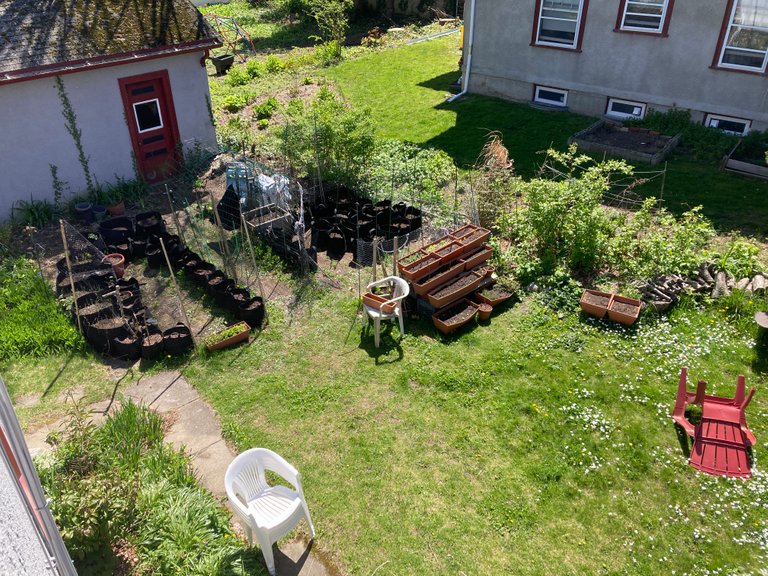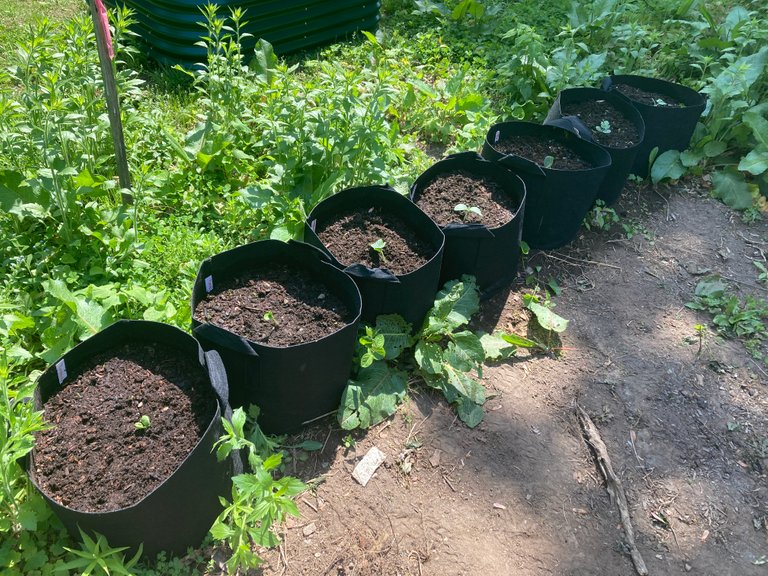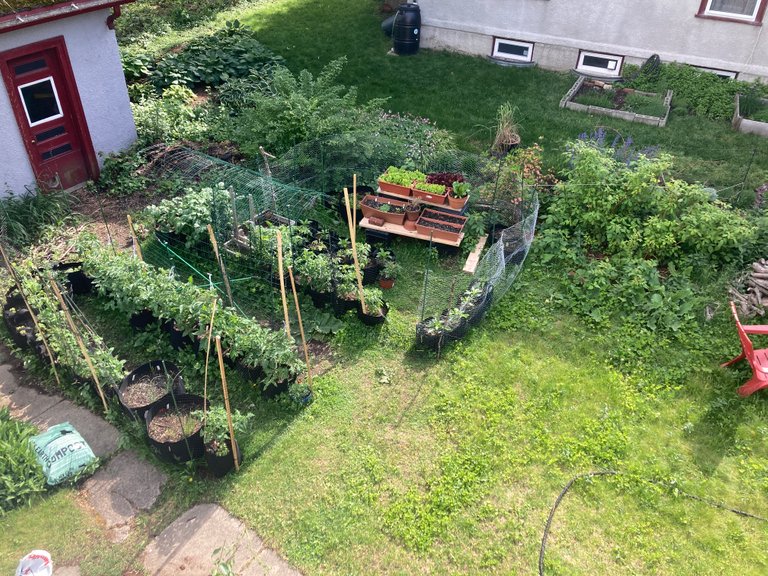The Many Gardening Methods: Why I Picked Mine?

Above: My Grow Bag Garden
As I look forward to the GrovVid 23 gardening season, year 4 of my GroVid Challenge garden, I am going to look back at some of my choices to date: Why Fabric GrowBags? Follow along as I go thru my thoughts on why I choose to use Grow Bags for my gardening method.
Light, Heat, Oxygen, Something to grow in, and Nutrients
These are the major things a plant needs to grow. Light, usually, from the sun. Heat, again, the sun, warms the earth, and a seed starts to grow. Oxygen? All our garden plants *on earth* need oxygen to grow. Sure some in the briny deep do not, but I chose to focus on gardening. Something to grow in? Soil, usually, although in nature, plants also grow in water, think Water Lilies, and more, growing hydroponically. And of course, lastly, nutrients… lastly, because, seeds contain enough nutrients for most seedlings to start growing.
Gardening: Traditional Gardening, Farming, Hydroponics, Hügelkulture, No Till, Square Foot, Raised Beds, Permaculture, Grow Bags, Pots, and more!
There are as many ways to garden as there are Gardeners! These are really a few of the most popular. Many gardeners follow along with one or more of these principles.
There are as many ways to garden as there are Gardeners! These are really a few of the most popular. Many gardeners follow along with one or more of these principles.
Traditional Gardening is almost like scaled down Large Scale Farming. Rows of orderly plants, many of the same type grouped together for ease of watering, fertilizing and harvesting. One advantage, aside from the orderly beauty of the plantings, is ease of access, for planting, weeding, and harvesting. Neat rows allow the gardener to walk along and pull weeds, till, and later harvest. The big downside is the amount of work. This method is ideally suited for mechanized farming. It requires more water, more fertilizer and is actually one of the worst for the soil life.
Hydroponics is a method of growing without soil, and using water at the growth medium. It requires more labor, and constant monitoring for fertilizer. It has the advantage of being able to grow more in smaller spaces. All you need is more fertilizer. And monitoring. And more labor.
Hügelkulture is almost like growing in a forest. Essentially, it is the process of using many of the same principles of a typical wild forest, and mimicking that natural processes there, for growing. Many gardeners combine Hügelkulture and Raised Beds. In Hügelkulture, the base of the garden bed is large tree limbs and stumps. On top of that, is smaller branches, and sticks. Soil is added, to fill gaps, and then a latter of twigs and soil. Finally, a top dressing of only soil is used. The theory is, that as the stumps and sticks break down, this becomes much organic matter holding large amounts of water and nutrients. With a large enough growing space, Hügelkulture is an ideal way to grow your vegetables, fruits, and trees. Many people simply do not have space for this method, or there are nosy neighbors and Home Owner Associations that forbid large raised beds of this type.
No Till Gardening is as the name implies. The top most section of a garden is richest in soil life and bacteria. Perhaps that top 4 to 6 inches (10 cm to 15cm) is where most of the nutrient exchange between roots and beneficial bacteria helps plants grow. However, the beneficial bacteria are very sensitive to sunlight, as it’s UV rays can kill many bacteria. Thus: No Till. Simply by not turning over the ground, can more bacteria survive. No Till also helps to lessen compaction of soil with less people walking on the soil, less machinery compacting soil, and thus allowing more aerated soil.
Square Foot Gardening is a method of planting densely in small spaces, often a raised bed, that involves a lot of labor, fertilizer and planning to ensure a larger harvest. It is a densely populated space, often combining companion planting, to help maximize the limited space. As mentioned, it may take more labor, to help make sure the densely planted growth gets the needed sunlight, and nutrients required. Many small kitchen gardens utilize Square Foot methods: a few tomato, pepper plants, and herbs.
Raised Beds are simply a method of growing the garden above the natural soil level using one the principles of the many methods I am mentioning: Hügelkulture, No Till, Square foot, etc. Some people enjoy Raised Beds to help bring the plants to them, rather than bend over and go to the plants. Raised beds can be 6 inches (15 cm), a foot, but are often about 3 foot tall (1 meter) as popularized by the Birdies Beds, Vego, or other well known brand metal raised beds now on the market. They certainly do help the back and knees!
Permaculture is a method used where you emulate nature. Building soil from the top down. Basically, laying a new layer on top, as found in the natural world. This method is more hands off, and can result in a very rich soil, with ideal fluffy conditions. It does take a longer time frame, not something done in one or even a couple of garden seasons. Laying rich compost, sticks, greens, and more on top each year produces great result, but needs time as it’s biggest factor for success. Again, many HOA’s are cranky, and often object to larger raised beds, that accompany many Permaculture projects.
Above: 10 gallon (37liter) Woven Fabric Grow Bags, used for pumpkin, and squash

And now, the method I have settled on: Grow Bags. Similar to potted plants, but with some major differences. Fabric Grow Bags are usually made from Fabric, often Felt, Nylon, or Canvas. Grow Bags, like pots, are ideally suite for one or two plants at a time, and allow for specific feeding of individual plant types. Two bags near each other can have very different plants Thant have their own unique fertilizer needs: one needs High Nitrogen and One needs potassium, for instance.
Above: 25 gallon(95 liter) Woven Fabric Grow Bags, 7 gallon (26liter) used for Pepper, and a pot for growing Marigolds to attract pollinators!

The Grow Bags I use are woven fabric, semi-permeable, meaning both water and oxygen get flow thru. Often Grow Bags need more water than soil based beds, as water flows out. That means, more fertilizer as water washing some nutrients away. The semi-permeable barrier also allows oxygen in, and that gives the major advantage over potted plants. Where potted plants’ roots grow until they hit a side, and then, grow in a circle round, the Fabric Grow Bag plant root grows and stops at the side: Called Air Pruning, as the root stops at the oxygen barrier. This forces the plants to grow more roots in the interior of the grow bag compared to potted plants. No Root bound plants, more roots, allows for more root/nutrient surface area.
Above: Another Aerial shot (from GroVid2021) of my Fabric Grow Bags. I grow some herbs in 1 gallon bags, some peppers and herbs in 5 gallon bags, tomato, pepper, zucchini, and some small squash in 7 gallon, some larger squashes in 10 gallon, onions, garlic and potato in 25 gallon fabric grow Bags.

As long as you understand the advantages and disadvantages of growing methods, there is no right or wrong. There may be a better solution for you, individually as a gardener, but, no one method is the perfect solution for everyone. For me, I know, Fabric Grow Bags need more water, and more fertilizer, compared to beds. But it is an ideal solution for someone with limited yard space, and a obsessive desire for growing.
No matter what comes though, a part of me is always focused on feeding my family and friends fresh, healthy, home grown foods. Growing my own fresh, healthy food locally, is better for the planet, better for my own family.
What method are you using with your gardens for your family?
Let me know below in the comments...
Let me know below in the comments...
Leave me a comment, below...
and a link to your #GroVid22 garden!

your own health and your own lives.
In the coming year, the GroVid23 Challenge:
Grow Your OWN is not just a simple short challenge,
it's about taking control of your future!
Are you planning? Are you ready?
It's coming soon!
BluefinStudios






0
0
0.000















View or trade
BEER.Hey @bluefinstudios, here is a little bit of
BEERfrom @pixresteemer for you. Enjoy it!Did you know that <a href='https://dcity.io/cityyou can use BEER at dCity game to buy cards to rule the world.
I use mostly raised beds with some traditional beds. I chose raised beds because of poor local soil quality. I could have used grow bags but was not familar with them at the time. Nice, informative post as always 👍
thanks!
When (not if) when I finally move, I will probably add some large raised beds. I love the grow bags, but, look forward to raised beds at about 30-36 inch height. Depending on terrain, I will do metal raised beds, or possibly 4x4/6x6 timber, to create raised beds.
Hope the Holidays were amazing for you and yours!
Your garden is best.
thank you. I work hard at it
https://twitter.com/1602924208522203137/status/1607572253667119105
The rewards earned on this comment will go directly to the people( @nishani9 ) sharing the post on Twitter as long as they are registered with @poshtoken. Sign up at https://hiveposh.com.
Thank you for sharing this post on HIVE!
Your content got selected by our fellow curator rezoanulvibes & you just received a little thank you upvote from us for your great work! Your post will be featured in one of our recurring compilations which are aiming to offer you a stage to widen your audience within the DIY scene of Hive. Stay creative & HIVE ON!
Please vote for our hive witness <3
Dear @bluefinstudios,
Your support for the current HiveBuzz proposal (#199) is much appreciated but it will expire end of December!
May we ask you to review the new proposal (#248) and renew your support so that our team can continue their work next years?
You can support the new proposal on Peakd, Ecency, Hive.blog or using HiveSigner.
https://peakd.com/proposals/248
We wish you a Happy New Year!
Cool .... I like this small garden :)
I must next summer try this bag idea .... but I must find more bigger ones , small ones are not very good for lot plants .
I use bags from tiny 1 gallon (3.75l) to 5 gallon (19l), most of mine are 7 gallon (26l) and 10 gallon (38l) and a few are even 25 gallon (95l)
Most plants grow in the 7 gallon and are happy. Tomato, Pepper, Squash, Zucchini, and more!
I soon see .... I just need to try all , small ones was not very good here , so I try big ones next :))
If you cannot find big bags, use those big BUCKETS... just remember drill lots of holes in bottom to allow water to drain.
YEs .... holes they need lot , it is normal thing to do :) .... soon is 2023 and I can start soon ;)
WHat plant is the most strong in your small garden ? :)